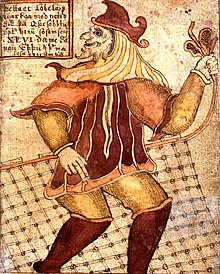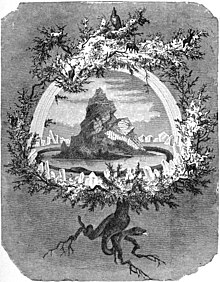Norse mythology

| Mythology |
|---|
Norse, Nordic, or Scandinavian mythology, is the body of myths belonging to the North Germanic peoples, stemming from Old Norse religion and continuing after the Christianization of Scandinavia, and into the Nordic folklore of the modern period. The northernmost extension of Germanic mythology and stemming from Proto-Germanic folklore, Norse mythology consists of tales of various deities, beings, and heroes derived from numerous sources from both before and after the pagan period, including medieval manuscripts, archaeological representations, and folk tradition. The source texts mention numerous gods such as the thunder-god Thor, the raven-flanked god Odin, the goddess Freyja, and numerous other deities.

Most of the surviving mythology centers on the plights of the gods and their interaction with several other beings, such as humanity and the
Norse mythology has been the subject of scholarly discourse since the 17th century when key texts attracted the attention of the intellectual circles of Europe. By way of
Terminology
The historical religion of the Norse people is commonly referred to as Norse mythology. Other terms are Scandinavian mythology,[1][2][3] North Germanic mythology[4] or Nordic mythology.[5]
Sources
Norse mythology is primarily attested in dialects of
The Prose Edda was composed as a prose manual for producing skaldic poetry—traditional Old Norse poetry composed by skalds. Originally composed and transmitted orally, skaldic poetry utilizes alliterative verse, kennings, and several metrical forms. The Prose Edda presents numerous examples of works by various skalds from before and after the Christianization process and also frequently refers back to the poems found in the Poetic Edda. The Poetic Edda consists almost entirely of poems, with some prose narrative added, and this poetry—Eddic poetry—utilizes fewer kennings. In comparison to skaldic poetry, Eddic poetry is relatively unadorned.[6]
The Prose Edda features layers of euhemerization, a process in which deities and supernatural beings are presented as having been either actual, magic-wielding human beings who have been deified in time or beings demonized by way of Christian mythology.[7] Texts such as Heimskringla, composed in the 13th century by Snorri and Gesta Danorum, composed in Latin by Saxo Grammaticus in Denmark in the 12th century, are the results of heavy amounts of euhemerization.[8]
Numerous additional texts, such as the
Objects from the archaeological record may also be interpreted as depictions of subjects from Norse mythology, such as amulets of the god Thor's hammer
Only a tiny amount of poems and tales survive of the many mythical tales and poems that are presumed to have existed during the Middle Ages, Viking Age, Migration Period, and before.[14] Later sources reaching into the modern period, such as a medieval charm recorded as used by the Norwegian woman Ragnhild Tregagås—convicted of witchcraft in Norway in the 14th century—and spells found in the 17th century Icelandic Galdrabók grimoire also sometimes make references to Norse mythology.[15] Other traces, such as place names bearing the names of gods may provide further information about deities, such as a potential association between deities based on the placement of locations bearing their names, their local popularity, and associations with geological features.[16]
Mythology
Gods and other beings

Central to accounts of Norse mythology are the plights of the gods and their interaction with various other beings, such as with the jötnar, who may be friends, lovers, foes, or family members of the gods. Numerous gods are mentioned in the source texts. As evidenced by records of personal names and place names, the most popular god among the Scandinavians during the Viking Age was Thor the thunder god, who is portrayed as unrelentingly pursuing his foes, his mountain-crushing, thunderous hammer Mjölnir in hand. In the mythology, Thor lays waste to numerous jötnar who are foes to the gods or humanity, and is wed to the beautiful, golden-haired goddess Sif.[17]
The god
Odin must share half of his share of the dead with a powerful goddess,
While they receive less mention, numerous other gods and goddesses appear in the source material. (For a list of these deities, see
Various beings outside of the gods are mentioned.
Cosmology


In
The afterlife is a complex matter in Norse mythology. The dead may go to the murky realm of
Humanity
According to the Prose Edda and the Poetic Edda poem, Völuspá, the first human couple consisted of Ask and Embla; driftwood found by a trio of gods and imbued with life in the form of three gifts. After the cataclysm of Ragnarok, this process is mirrored in the survival of two humans from a wood; Líf and Lífþrasir. From these two humankind is foretold to repopulate the new and green earth.[34]
See also
- Alliterative verse
- Family tree of the Norse gods
- Project Runeberg
- List of Germanic deities
- List of valkyrie names in Norse mythology
- Greek mythology
- Roman mythology
- The horse in Nordic mythology
References
- ^ Rooth, Anna Birgitta (1961). Loki in Scandinavian Mythology. C. W. K. Gleerup. Archived from the original on 19 April 2023. Retrieved 7 September 2018.
- ISBN 9514108094. Archivedfrom the original on 19 April 2023. Retrieved 3 October 2020.
- ISBN 0824091736. Archivedfrom the original on 19 April 2023. Retrieved 7 September 2018.
- ISBN 157113199X., the Icelandic scholar and politician, who did our knowledge of heathen religion such good service... he offers a scholarly portrayal of Old Norse mythology, which is admittedly heavily influenced by his Christian education and classical education, but remains nonetheless our most important medieval source for North Germanic mythology.
Of even more importance is Snorri Sturluson
- ISBN 9780486119359. Archivedfrom the original on 19 April 2023. Retrieved 7 September 2018.
- ^ a b Faulkes (1995), pp. vi–xxi, and Turville-Petre (1964), pp. 1–34.
- ^ Faulkes (1995), pp. xvi–xviii.
- ^ Turville-Petre (1964), pp. 27–34.
- ^ Lindow (2001), pp. 11–12, Turville-Petre (1964), pp. 17–21, and MacLeod & Mees (2006), pp. 27–28, 216.
- ^ Regarding the dísir, valkyries, and figurines (with images), see Lindow (2001), pp. 95–97. For hammers, see Simek (2007), pp. 218–19, and Lindow (2001), pp. 288–89.
- ^ Lindow (2001), pp. 29–30, 227–28, and Simek (2007), pp. 84, 278.
- ^ Puhvel (1989), pp. 189–221
- ^ Mallory (2005), pp. 128–42
- ^ Turville-Petre (1964), p. 13.
- ^ Regarding Ragnhild Tregagås, see MacLeod & Mees (2006), p. 37. For Galdrabók, see Flowers (1989), p. 29.
- ^ Turville-Petre (1964), pp. 2–3, 178.
- ^ Lindow (2001), pp. 287–91.
- ^ Lindow (2001), pp. 128–29, 247–52.
- ^ Lindow (2001), pp. 118, 126–28.
- ^ Lindow (2001), pp. 121–22.
- ^ Lindow (2001), pp. 241–43.
- ^ Lindow (2001), pp. 311–12.
- ^ Lindow (2001), pp. 86–88, 135–37, 168–72, 198–99, 297–99.
- ^ Lindow (2001), pp. 99–102, 109–10, and Simek (2007), pp. 67–69, 73–74.
- ^ Simek (2007), pp. 108–09, 180, 333, 335.
- ^ Lindow (2001), pp. 95–97, 243–46. Simek (2007), pp. 62–62, 236–37, 349.
- ^ Lindow (2001), pp. 319–32. Simek (2007), pp. 375–76.
- ^ Lindow (2001), pp. 91–92, 205–06, 222–23, 278–80.
- ^ For Hel, see Lindow (2001), p. 172, and Orchard (1997), p. 79. For Valhalla, see Lindow (2001), pp. 308–09, and Orchard (1997), pp. 171–72. For Fólkvangr, see Lindow (2001), p. 118, and Orchard (1997), p. 45.
- ^ For Rán, see Lindow (2001), pp. 258–59, and Orchard (1997), p. 129. For Gefjon, see Orchard (1997), p. 52.
- ^ Orchard (1997), p. 131.
- ^ Lindow (2001), pp. 42–43.
- ^ Lindow (2001), pp. 1–2, 40, 254–58.
- ^ Simek (2007), p. 189.
General sources
- Edda: Snorri Sturluson. Translated by ISBN 0-460-87616-3.
- ISBN 0-87728-685-X.
- ISBN 0-19-515382-0.
- MacLeod, Mindy; Mees, Bernard (2006). Runic Amulets and Magic Objects. ISBN 1-84383-205-4. Archivedfrom the original on 19 April 2023. Retrieved 17 October 2015.
- ISBN 0-500-27616-1.
- ISBN 0-304-34520-2.
- ISBN 0-8018-3938-6.
- Turville-Petre, E. O. G. (1964). Myth and Religion of the North: The Religion of Ancient Scandinavia. Holt, Rinehart and Winston.
- ISBN 978-0-85991-513-7.
Further reading
General secondary works
- Abram, Christopher (2011). Myths of the Pagan North: the Gods of the Norsemen. London: Continuum. ISBN 978-1-84725-247-0.
- Aðalsteinsson, Jón Hnefill (1998). A Piece of Horse Liver: Myth, Ritual and Folklore in Old Icelandic Sources (translated by Terry Gunnell & ISBN 9979-54-264-0.
- Andrén, Anders. Jennbert, Kristina. Raudvere, Catharina. (editors) (2006). Old Norse Religion in Long-Term Perspectives: Origins, Changes, and Interactions. Lund: Nordic Academic Press. ISBN 91-89116-81-X.
- Branston, Brian (1980). Gods of the North. London: Thames and Hudson. (Revised from an earlier hardback edition of 1955). ISBN 0-500-27177-1.
- Christiansen, Eric (2002). The Norsemen in the Viking Age. Malden, Mass.: Blackwell. ISBN 1-4051-4964-7.
- Clunies Ross, Margaret (1994). Prolonged Echoes: Old Norse Myths in Medieval Northern Society, vol. 1: The Myths. Odense: Odense Univ. Press. ISBN 87-7838-008-1.
- ISBN 0-14-013627-4. (Several runestones)
- ISBN 0-87226-041-0. Reissued 1996 as Viking and Norse Mythology. New York: Barnes and Noble.
- ISBN 0-8156-2438-7.
- ISBN 0-415-04937-7.
- de Vries, Jan. Altgermanische Religionsgeschichte, 2 vols., 2nd. ed., Grundriss der germanischen Philologie, 12–13. Berlin: W. de Gruyter.
- DuBois, Thomas A. (1999). Nordic Religions in the Viking Age. Philadelphia: Univ. Pennsylvania Press. ISBN 0-8122-1714-4.
- ISBN 0-520-03507-0.
- ISBN 0-486-43549-0.
- ISBN 0-8240-9173-6.
- ISBN 0-19-515382-0. (A dictionary of Norse mythology.)
- Mirachandra (2006). Treasure of Norse Mythology Volume I ISBN 978-3-922800-99-6.
- ISBN 3-900538-57-3.
- O'Donoghue, Heather (2007). From Asgard to Valhalla: the remarkable history of the Norse myths. London: I. B. Tauris. ISBN 1-84511-357-8.
- Orchard, Andy (1997). Cassell's Dictionary of Norse Myth and Legend. London: Cassell. ISBN 0-304-36385-5.
- Page, R. I. (1990). Norse Myths (The Legendary Past). London: British Museum; and Austin: University of Texas Press. ISBN 0-292-75546-5.
- Price, Neil S (2002). The Viking Way: Religion and War in Late Iron Age Scandinavia. Uppsala: Dissertation, Dept. Archaeology & Ancient History. ISBN 91-506-1626-9.
- Simek, Rudolf (1993). Dictionary of Northern Mythology. Trans. Angela Hall. Cambridge: D. S. Brewer. ISBN 0-85991-513-1.
- Simrock, Karl Joseph (1853–1855) Handbuch der deutschen Mythologie.
- Svanberg, Fredrik (2003). Decolonizing the Viking Age. Stockholm: Almqvist & Wiksell. ISBN 9122020071(v. 2).
- ISBN 0-8371-7420-1.
Romanticism
- Anderson, Rasmus (1875). Norse Mythology, or, The Religion of Our Forefathers. Chicago: S.C. Griggs.
- ISBN 0-486-27348-2.
- Keary, A & E (1909), The Heroes of Asgard. New York: Macmillan Company. Reprinted 1982 by Smithmark Pub. ISBN 0-333-07802-0.
- ISBN 0-7818-0770-0.
- Mackenzie, Donald A (1912). Teutonic Myth and Legend. New York: W H Wise & Co. 1934. Reprinted 2003 by University Press of the Pacific. ISBN 1-4102-0740-4.
- ISBN 0-7661-8891-4.
Modern retellings
- Bradish, Sarah Powers (1900). Old Norse stories. New York: American Book Company / Internet Archive.
- ISBN 0-689-86885-5.
- ISBN 0-14-025869-8.
- d'Aulaire's Book of Norse Myths". New York, New York Review of Books.
- ISBN 0-404-04538-3.
- ISBN 0-393-60909-X.
- Syran, Nora Louise (2000). Einar's Ragnarok
External links
 Media related to Norse mythology at Wikimedia Commons
Media related to Norse mythology at Wikimedia Commons
